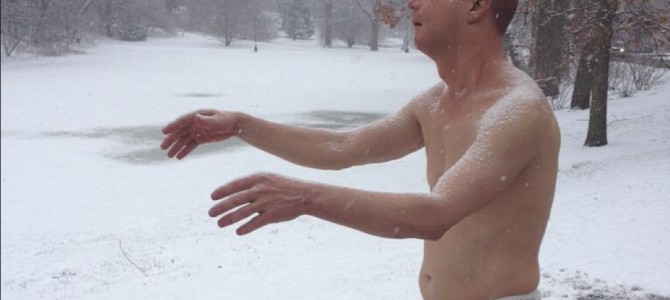
A Tony Matelli exhibit opens at Wellesley College’s Davis Museum today. But the installation of one of his pieces of art in a common area is unacceptable, according to students demanding its removal. The statue, pictured above, is of a man in underwear, sleepwalking with arms outstretched. Modern sculpture might suffer from being too abstract and too ugly but at least on the former point, this is the real deal. And perhaps because of its realism, the artist has created something quite provocative.
Perhaps too provocative.
In a move so cliched it could come from the Book of Walking Stereotypes, a Wellesley student has created a petition on Change.org demanding the statue’s removal:
President H. Kim Bottomly: Remove the uncomfortable and potentially triggering statue put up without student consent.
The statue of the nearly naked man on the Wellesley College campus is an entirely inappropriate and potentially harmful addition to our community that we, as members of the student body, would like removed immediately. While it appears that this statue of a nearly naked, older white man with outstretched arms is an art installation, it does not provide our community with any of the value that art is traditionally intended to add. On contrary, this highly lifelike sculpture has, within just a few hours of its outdoor installation, become a source of apprehension, fear, and triggering thoughts regarding sexual assault for many members of our campus community. While it may appear humorous, or thought-provoking to some, it has already become a source of undue stress for many Wellesley College students, the majority of whom live, study, and work in this space.
This sculpture, if it is to be displayed at all, should be placed inside the Davis Museum where it cannot surprise and distress students who must travel past it outdoors. We request that upon its removal from a public, outdoor space, the sculpture be placed inside the Davis Museum, in a location other than the lobby. While art holds a valuable place in our community, we are particularly concerned that the student body was not consulted on such a sensitive and potentially upsetting matter, particularly given that this installation was placed in a highly trafficked location, with no real option for students to avoid it. We expect that the College will act accordingly, with respect for it’s student body, by removing this piece of artwork as soon as possible, and consulting it’s students about similar matters in the future.
-Lauren Walsh, Class of 2014
If you’d prefer, here’s a dramatic reading of the petition. But the bottom line is that we have triggering, micro-aggression, white privilege and a whole mess of other problems. It appears we have a major breakdown at the elite women’s school just outside of Boston.
For those unaware, “triggering” is a word you come across frequently on feminist sites. Take it away 2010 blog post from progressive feminist blog Shakesville:
A trigger is something that evokes survived trauma or ongoing disorder. For example, a person who was raped may be “triggered,” i.e. reminded of hir [sic] rape, by a graphic description of sexual assault, and that reminder may, especially if the survivor has post-traumatic stress disorder, be accompanied by anxiety, manifesting as anything ranging from mild agitation to self-mutilation to a serious panic attack.
OK, so it’s not just some student going off here against this piece of art. She’s gotten, at the time I’m looking at this, more than 200 supporters for her efforts to remove the offending art. The entire student body is only 2,400 or so students. Lisa Fischman, director of the museum, responded charitably on the Change.org site:
Thank you for your engagement and for your thoughtful response to Tony Matelli’s Sleepwalker, which was installed this afternoon on the Wellesley campus.
Art has an extraordinary power to evoke personal response, and to elicit the unexpected. We placed the Sleepwalker on the roadside just beyond the Davis to connect the exhibition — within the museum — to the campus world beyond. I love the idea of art escaping the museum and muddling the line between what we expect to be inside (art) and what we expect to be outside (life). I watched from the 5th floor windows today (intermittently, over several hours) as students stopped to interact playfully with the sculpture. They took selfies with him, snapping pics with their phones, and gathering to look at this new figure on the Wellesley landscape — even as the snow fell.
Matelli’s Sleepwalker — considered up close — is a man in deep sleep. Arms outstretched, eyes closed, he appears vulnerable and unaware against the snowy backdrop of the space around him. He is not naked. He is profoundly passive. He is inert, as sculpture. But he does inspire narrative. He appears to have drifted away from wherever he belongs and one wonder why; one wonders also how he has gotten so lost, so off course. He is a figure of pathos, and one that warrants measured consideration. Perhaps he carries metaphorical weight.
Art provokes dialogue, and discourse is the core of education. In that spirit, I am enormously glad to have your response.
In a story on the dust-up at Boston.com, students reacted to the piece. This has to be my favorite line:
“I think art’s intention is to confront, but not assault, and people can see this as assaulting,” [Wellesley College senior Annie Wang, an art history major,] said.
Other students from the school Hillary Rodham Clinton attended weighed in at the petition site. Here are some of the most interesting remarks:
- Our safe space – the only safe space for some of us – is being heavily compromised, and the fact that you are choosing to defend the statue before considering students’ comfort-levels is a shame.
- Matelli’s statue does not speak to the power of art to inspire dialogue but rather to the power of the nearly nude, white, male body to disturb and discomfit. Even unconscious and vulnerable, he is threatening. “Arms outstretched, eyes closed,” he lumbers forward, quite literally unable to acknowledge the presence of his (in this context) largely female spectators. What a perfect representation of the world outside of Wellesley, where women and people identifying as women are often subject to a similar ambivalence. “I’m not even conscious that I’m wandering through your lady landscape,” the statue says. “I do not have to experience you. I feel about you the same way I feel about the snow. But you have to experience me, and I don’t care.”
- What does this statue do if not remind us of the fact of male privilege every single time we pass it, every single time we think about it, every single time we are forced to acknowledge its presence. As if we need any more reminders.
- Your claim that Sleepwalker is passive is spoken in privilege and without regard to the many students on this campus who have faced and survived assault, racism, and many other forms of violent oppression.
- Even having seen a picture of the statue taken during the day, and even having been told where it was, it still unnerved me as I walked from the Campus Center to Tower. I could not tell whether I was looking at the statue I’d heard about or a real, potentially dangerous man wandering around until I had reached the intersection. That is a rather long time to be so needlessly stressed out.
- The sculpture can traumatize and terrorize students on campus who deserve a safe place. To some extent, I personally see it as sexual harassment by proxy.
- As a Wellesley alumna I am horrified that no one with decision making power at the Davis Museum stopped to consider the fear and anxiety this installation could trigger. They couldn’t have chosen a more clothed less menacing sculpture from the same exhibit to put outside? The students and larger community deserve better, they deserve consideration.
- Wellesley of all places should understand how shocking and triggering a nearly naked man standing in the middle of campus could be. What emotions are attempting to be stirred by this art?? Hopefully not fear, as we women encounter frightening situations on a regular basis simply because of our gender. We do not need to be afraid, startled, or thought-provoked by a naked man in our safe space.
When I first started reading through these comments and the entire effort to get rid of the sleepwalker, I thought everything about it ridiculous. But as I see each mention of “triggering” and fear, I can’t help but think that whatever aspect of feminism is on display resembles something of a modern chivalry, the means by which we protect the weaker sex from the cruelties of the world.
There’s no doubt that the “virtuous” men of previous eras would have kept Matelli’s “Sleepwalker” from assaulting fragile women on a college campus. They would have enforced rigorous codes of conduct about how to treat women sought for marriage. They would have punished men who behaved improperly. Now we have Change.org petitions and SlutWalks and Take Back The Night rallies.
Traditionalists who wonder about the appeal of these things might take heart at one of the deeper truths on display — women know that the sexes are not indistinguishable. They know that unbridled lusts can be dangerous. And they seek and desire protection from the threats of the outside world.









